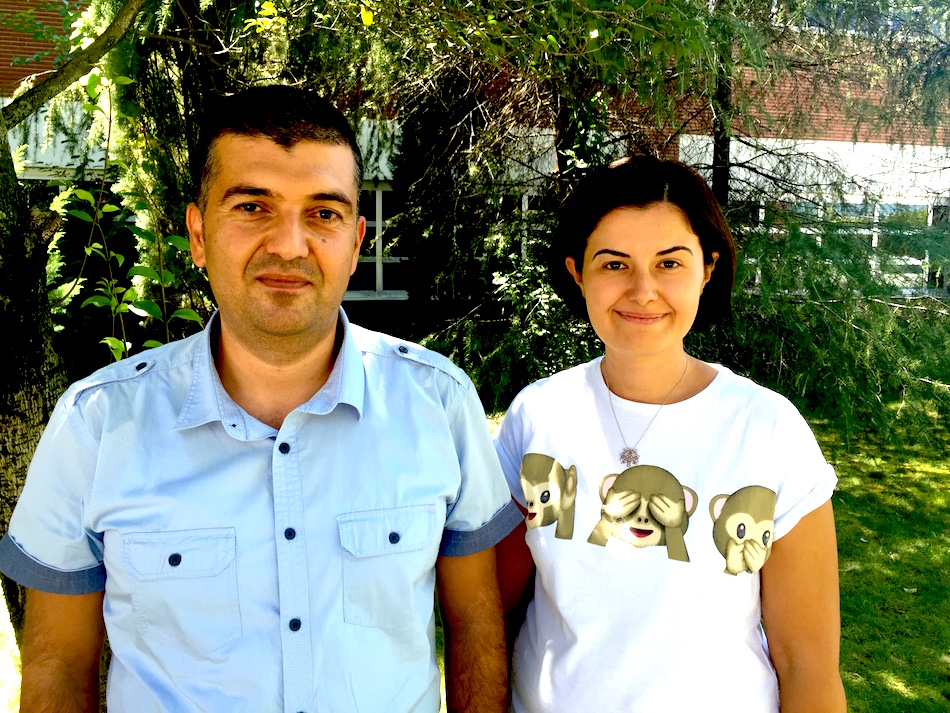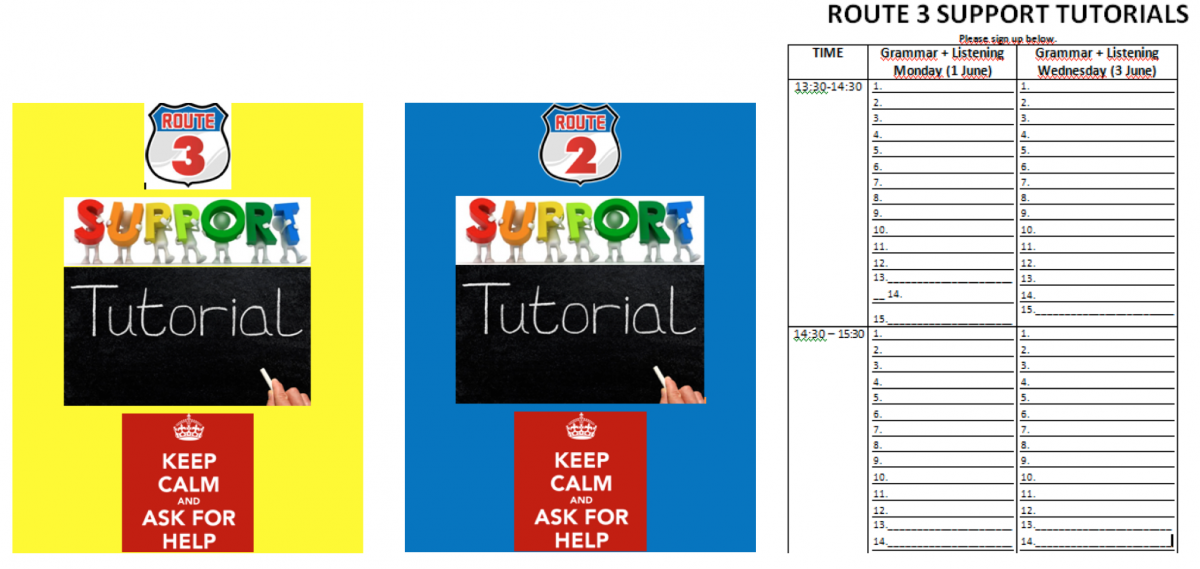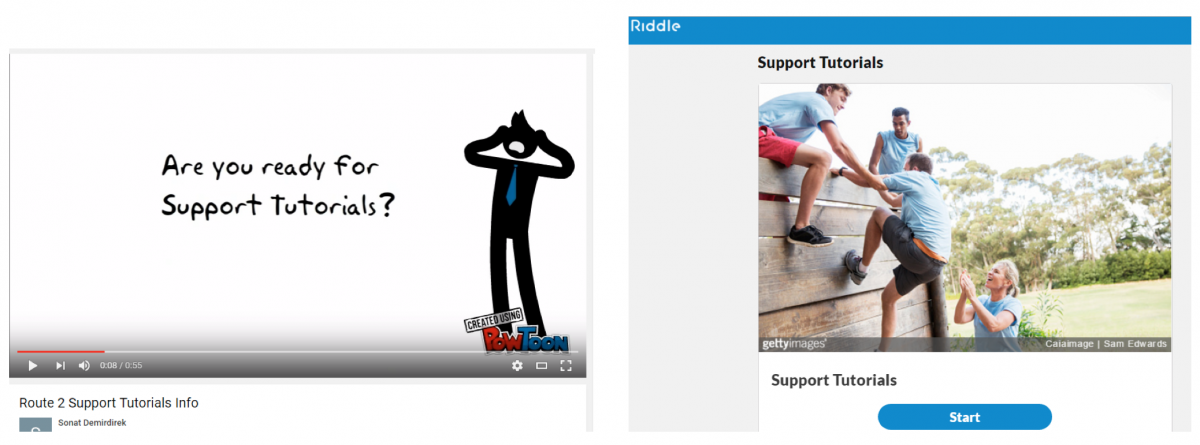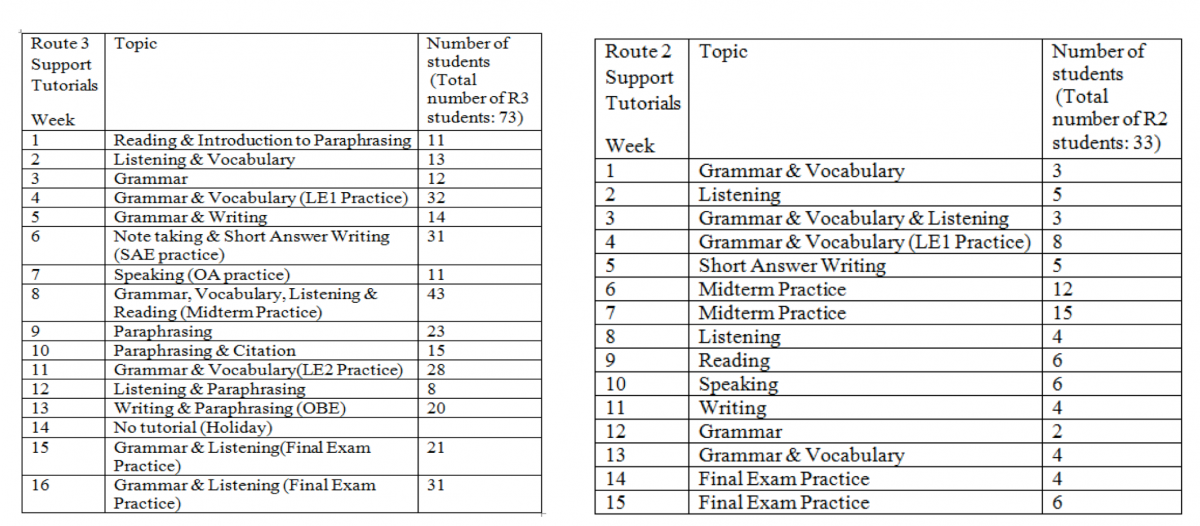How to Support Students through Tutorials
by
Neslihan & Sonat Demirdirek

In the School of Languages (SL), support tutorials for students at a certain level have been in practice for quite a long time. They were done in different formats by different teachers in the past. Based on the feedback from previous semesters, last year, at Route 3, we tried to find out a way to organise support tutorials in order to maximise the benefits. We mainly brainstormed ideas both for administration and content of these tutorials. In spring 2015, the support tutorials received positive feedback from both students and teachers. Based on this feedback, we were asked to give support tutorials for Route 2 (Pre-Intermediate) (Sonat) and Route 3(Intermediate) (Neslihan) in Spring 2016. Here, we will explain the administration and the content of the tutorials together with feedback from students and our reflections on the tutorials.
Administration:
First of all, we booked the same classroom for the whole semester and we used the same classroom for the same days and the same time every week. This makes it easier to remember and attending tutorials becomes a habit. In addition, we prepared a poster and put it on the door of the classroom. Every week, we put up a signup sheet for the following week. The students who come one week could sign up for the following week while leaving the classroom. Although the sign up sheet was new for every week, the poster was on the door during the semester so that it would attract the attention of more students (Please see the poster and a signup sheet below).

In order to inform the students about the main focus of the tutorial for each week, we asked the teachers during level meetings and by email to make announcements in their classrooms. When the teachers encourage their students, they seem to attend more so this was important. During the semester, we also asked OLSP (Online Learning Support Project) member in each level to send emails through Sucourse+, the online learning platform for all Route 2 and Route 3 students. Informing students through different channels on different days is crucial as some of the students can easily forget the time, place and the subject. We tried out different methods in these emails to attract more students. For example, by using Powtoon, we prepared short youtube videos to inform students about the tutorials (Please see an example video below https://www.youtube.com/watch?v=fLQd2F1tuUM). Another example was a short quiz prepared by using Riddle (Please see the example quiz below https://www.riddle.com/a/55804 ). In addition, we tried to keep the groups small as the same material was used with different groups of students. This administration process was the first step to ensure a higher participation.

Content:
In the first week, we asked many students what they would like to study in the tutorials. None of the students wanted to come to tutorials with their questions or highlighted parts in the texts that they couldn’t understand or with circled questions from a specific material they used in class or outside class during self study time. Instead, all students said that they would like to see new practice materials for four skills as well as grammar and vocabulary. Therefore, we prepared new materials for each week. While deciding on the main focus for a specific week, we checked the calendar to see what had been covered until that day, what was being done in that specific week, what the main challenges for the students were and which exam was coming up. These were the main considerations while preparing the materials. Moreover, each week we got feedback from the students. They shared their opinions about the content, task types, their needs and expectations. These were all included as much as possible in the following week(s). A third starting point was our observations of students during tutorials and lessons. When we realised that most students found a skill, a grammar point or a question type challenging, we tried to incorporate that into our next tutorial(s). This provided students with an opportunity to practise. You can see the topics and number of students attending the tutorials each week in the chart below. As it can be seen, the attendance was the highest before exams. Most students believe that attending the tutorials just before a certain exam will help them perform better during the exam. Most of the students started attending regularly after coming to a tutorial before one of the first exams. Before the midterm exam, 43 out of 73 R3 students attended one of the four sessions. This was the highest number. However, after the midterm exam, some of the students who couldn’t get a high grade stopped attending classes and taking the exams. Consequently, the number of students attending tutorials also dropped. On the other hand, in Route 2 there were only 33 students so each week there were fewer students attending. However, those who came on a regular basis benefitted from the individual attention they got by asking their questions and doing the new practice materials. It was more challenging to motivate Route 2 students who all failed either Route 1 or Route 2 in the previous semester whereas Route 3 students were a mixed group with smaller number of failing students from previous Route 3 and a bigger number of successful Route 1 students from previous semester.

While preparing the materials, it is important to make sure that the tasks are at the right level. They should not be too challenging or too easy. In either case, students become discouraged. For example, it is difficult to find listening practice materials at the right level with the pace, the question types, the topic, the vocabulary and grammar used in the listening. Therefore, we tried to prepare our own listening materials by preparing the texts, questions and doing the recording. The same goes for short answer writing practice. You can see an example of a listening material for R3 and a short answer material for R2 below.
An example of a listening material for R3 & An example of a writing material for R2 (Please click here)
Feedback from Students:
All throughout the semester, we asked students for feedback every week. As we have considered several different points while organising and actually giving the tutorials, there was not any negative feedback. We both talked to regularly attending students and students who never came or came only once. We asked the second group why they never attended. They tend to be students who live off campus, who work part time or who prefer going to their dorms. The reasons are not related to the timing or the content of the tutorials.
When we asked the students who attended all tutorials, they seemed to be happy with the content, variety and the materials. Two students asked for more grammar teaching followed by practice. These students thought that they needed more explicit teaching of grammar. They also seemed to be happy with extra practice materials provided to students who attended the tutorials before midterm and short answer exam.
Another source of feedback was the Learner Forums. These are meetings at each level that are organised to receive feedback from student representatives from each class. Students share their opinions on a variety of topics related to the course including support tutorials. Both Route 2 and Route 3 students appear to be satisfied with these tutorials. They told that these tutorials helped them improve their English and thus perform better in the exams.
 Reflections:
Reflections:
The whole process of organising, preparing and giving the tutorials was an invaluable learning opportunity for us as teachers. First of all, the organisation part gave us a deeper insight into the course. The main objectives, task types, expectations from students all became clear while getting ready for tutorials. Working with different students one to one or in small groups helped us gain a different perspective. It is sometimes more difficult to observe individual challenges of our students during lessons as the class sizes tend to be bigger compared to a tutorial. Observing and listening to students about their needs, expectations and weaknesses also helped us plan our everyday teaching more efficiently. Moreover, preparing materials to practise a variety of skills has improved our skills in materials development, which is one of the most important skills for a teacher.
Our colleagues who would like to implement support tutorials might want to consider the following points:
• The first weeks need to be planned more carefully. Although the number of attending students might be small, these students will advertise and encourage more students to come in the following weeks. Therefore, the difficulty level, the content, the tasks and so on need to be planned carefully. Students who come in the first weeks should see materials reflecting the content in the lessons and benefit from the tutorial. Then they are more likely to tell their friends and the numbers may increase.
• Students usually attend with a friend or as a group. We have fewer students who come on their own. In different classes, groups of students should be encouraged to come together.
• When you have a support tutorial only to answer questions from students, it may not work well. It is important to prepare at least a few grammar questions about a recent grammar point as a starting point for the tutorial. Most students do not ask questions. They would like to see new practice materials. If they have a question, it is usually about a grammar topic.
• There should be a balance between exam preparation materials and the other materials improving their English skills for academic study in general. It is important to emphasize that the tutorials are not only for exam preparation. By doing this, many students will still attend the tutorials in the last week even though they are unlikely to pass the course as they need to get a very high score in the final exam or they are almost certain to pass as they need a very low score in the final exam. This is because these students start to change their mindset and perceive language learning as a process rather than passing a course.
• You might present and advertise the tutorials as a learning opportunity but some students will still consider them as an opportunity for exam practice. Therefore, the attendance is often higher just before exams. For example, 43 R3 students came before midterm.
• Most students do not sign up before coming to tutorials so not having enough copies might be a problem. You might have to make extra copies in the last minute or have too many copies.
• It is always a good idea to prepare more tasks. It is better to have more materials than fewer materials. You can ask a specific group of students to choose what to do and you can email the rest with an answer key afterwards.
